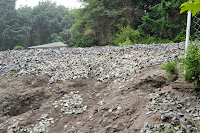 |
The grade immediate below the track
structure is called the subgrade. It was
disturbed by an excavator during a
recent construction project conducted
adjacent to the track.
|
 |
A rock slope was constructed to stabil-
ize and strengthen the subgrade for
more than 200 linear feet. Geotextile
fabric was placed below the rocks to
improve performance of saturated soils.
|
 |
A new rock slope below
the track at Snoqualmie
Falls.
|
The design uses "heavy loose rock," which are large rocks 30 inches and more across. It relies in part on prior stabilization work performed when soil anchors were driven under the track and a retaining wall was installed at the toe of the slope. To address the current issue, the slope on the subgrade below the track was covered with geotextile fabric and the heavy loose rocks were keyed into the sloped using an excavator. This design places several hundred tons of rock on the subgrade slope and restores integrity to the 1:1 zone beneath the track. However work did not stop there. Areas affected by construction activities that were outside the 1:1 zone but within the 2:1 slope of the railway grade are being strengthened with a foot or more of quarry spalls three to six inches in diameter.
Work took three days to perform and was completed between scheduled trains. What is most impressive to Spike is that the total elapsed time between discovering the issue and implementing final rehabilitation was just four days! Trains are continuing to operate and will resume track speed when authorities determine that stability has been fully restored. So a stable subgrade once again supports good track.

1 comment:
Discover how geotextile fabric is transforming the world of construction, landscaping, and environmental protection. From soil stabilization and erosion control to drainage and reinforcement, this innovative Geotextile 150 GSM plays a vital role in creating durable, eco-friendly, and cost-effective infrastructure. Learn how advanced geotextile materials, crafted by expert plastic sheet manufacturers in India, ensure long-lasting performance across roads, embankments, and landfills.
Post a Comment